Transparent recruiting
{Cover slide}
A presentation at UX Australia: Design Leadership 2022 in November 2022 in Sydney NSW, Australia by Jonathon Colman

{Cover slide}

Hi there. We’re going to start with an ice-cold open and jump directly into the data…

In August of 2021, over 4 million people in the US left their jobs. But that’s dwarfed by…

The 20 million people who left their jobs between April and August of the same year.

54% of US-based Gen Z workers are actively considering new jobs…

And it’s not just a phenomenon in the US—over 40% of global workers are thinking the same.

We’re in the midst of The Great Resignation, especially in Tech.
People are leaving their jobs like never before due to factors like burnout, a misalignment in values, mistreatment, systemic racism and sexism, underpaying vulnerable and marginalized groups of people, and more.

But due to Covid-19, The Great Resignation also coincides with the Remote Jobs Boom. This means that many people working in tech have more choice in their next employer than ever before.
This report from Dice dot com shows how tech job openings have rebounded since the start of the pandemic, showing double-digit year-over-year growth.

The tech jobs boom is a global phenomenon, stretching into Europe, Africa, Asia, South America, and beyond.
While it’s not evenly distributed, this jump in demand for tech workers means that they have significant leverage. Some are in a privileged position of being able to choose between multiple employers based all over the world.

And that leverage matters, because the pandemic has shifted many real-word physical services to go online. This has greatly accelerated the growth of companies providing those online services.
But in order to continue growing and achieving their missions, these companies will need to hire more people in the next 2 years than they did in the previous 10.
And some of them will have to hire even more people than that.

So: how will you hire them? There’s never been this many people with this much power and leverage being sought out by this many potential employers all at the same time.
How will you stand out? How will you speak to their very real needs? And why should people join your team instead of all the others out there?

That’s what this talk is all about.
Transparent recruiting is a new approach to working with candidates to earn their attention and build their confidence by being radically open with them.
More importantly, transparent recruiting is an equitable practice that reduces bias and helps to level the playing field so that all candidates can perform their best. It removes barriers to entry, reduces friction, and eases candidates’ fear and anxiety, all while helping you hire faster and better as you scale.

I’m Jonathon Colman, a senior design manager at HubSpot. I joined them in July of 2021 and by September, I needed to hire 9 new content designers, a number that increased rapidly once I got started.
In this talk, I’ll walk you through you the strategy I developed to make those hires. We’ll also look at plenty of examples from other companies around the world that support the principles I’ll be sharing with you.

You can find me on Twitter or LinkedIn at jcolman. Please reach out if you’ve got any questions or need more information.

And look: I know you’re probably watching this at home and you’re multi-tasking, taking care of your kids or pets, donating to support Ukraine, or leaving your home to get vaccinated or registered to vote.
That’s okay! You can find this talk and the nearly 40 resources and examples I mention all in one place: transparent recruiting dot com — that’s all one word.
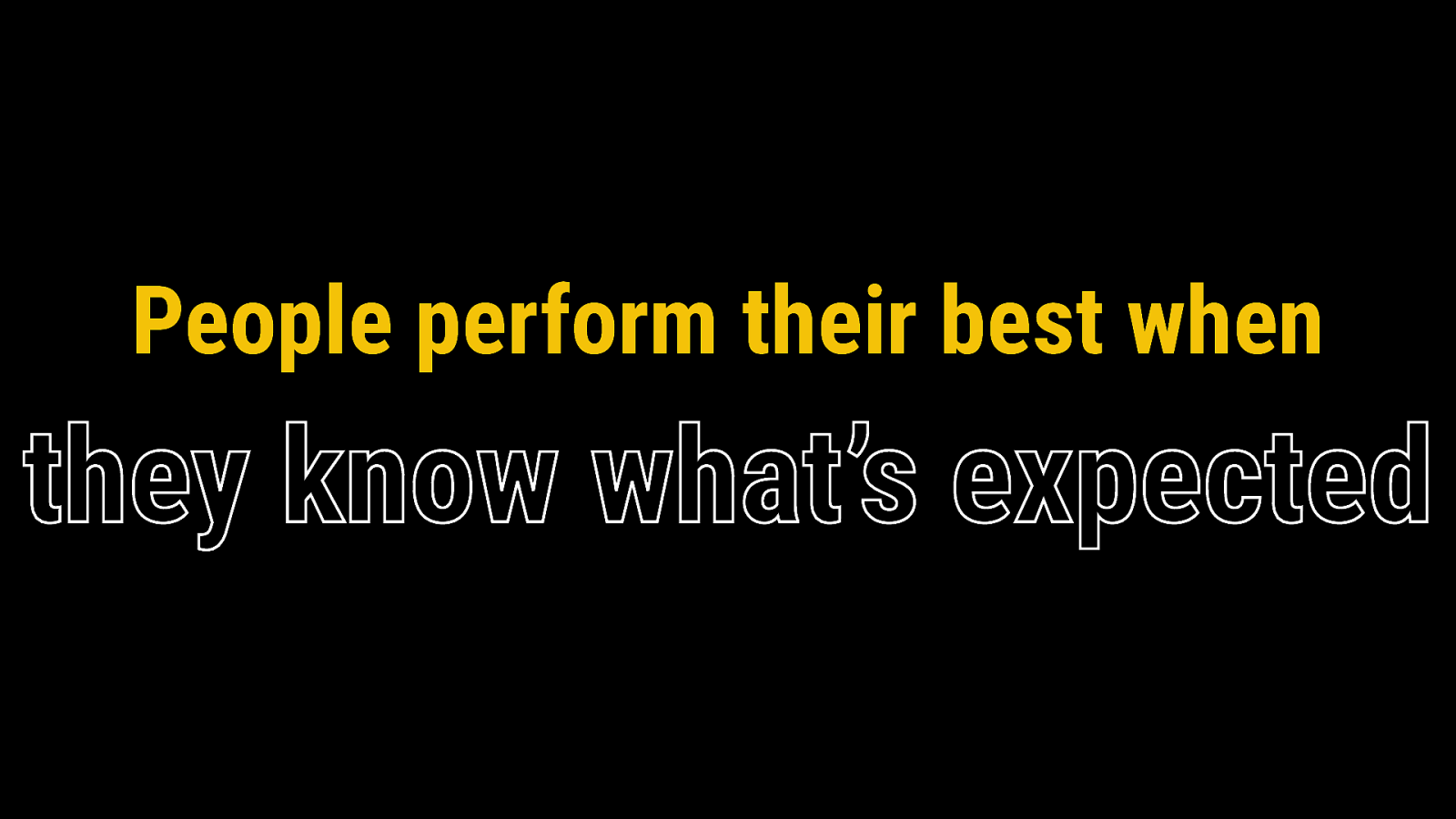
Here’s our core theme—we’ll come back to this many times. If you take away nothing else, try to keep this in mind: People will always perform their best when they know what’s expected of them.
I’m going to show you why setting clear expectations and coaching people to meet them can be a superpower when you’re hiring. And it also turns out that it’s good for candidates, too, because it alleviates their stress and anxiety by reducing ambiguity.
It also levels the playing field so that all sorts of people can succeed, not just people who look like me.

Let’s talk about why recruiting is so hard for so many people.
First of all, no one’s born a recruiter. So it’s normal not to know anything about it when you start. It’s something we have to learn and invest in practicing. And it’s important that we develop in recruiting because it’s one of the most important competencies for people managers.

But it’s a missing competency!

Almost none of us have a background in it. Or we assume it’s someone else’s job. Or no one’s trained us on how to do it well. Or we simply don’t have time for it.
So we often end up optimizing for shortcuts, like blast emails, social spam, and other outreach that scales.

But that tactic is how you end up with something like this—here’s a real email that Microsoft recruiters sent out to recruit interns at one of their events.
It’s hilariously inauthentic, off-brand, off-voice, and just… off. And rather than promote them as an employer, it made Microsoft the Main Character on Twitter for a week.
And if you think this is just a one-off, then you’re not paying attention. Go take a look at the Recruiting Hell sub-reddit for a firehose of the worst recruiting communications.

Much like we say about content strategy and UX, it turns out that recruiting is all about people.
And so maybe we should be a little less eager to scale, especially when we don’t have anything of substance to say.

If you’re building out a team, recruiting should be your #1 job. It requires your prioritization, focus, and deep investment of time.
That’s not meant to disrespect your recruiters or imply that they’re not talented or great at what they do. But they don’t have your domain expertise, your knowledge of the industry, or your familiarity with the people you want to reach.
More to the point: your recruiters want you to work with them!

This quote from Peter Merholz, co-author of Org Design for Design Orgs, says it all.
In high-growth organizations, Recruiting is the most impactful thing a hiring manager can do. That’s because hiring new people unlocks teams to solve customer problems, add new value to products, and otherwise fuel rapid growth.
So hiring managers need to lean in and invest deeply in recruiting.

Merholz goes on to show why managers don’t do this: it’s because of a vicious cycle.
You don’t have enough designers, so you lean in to do the work yourself, which means that you no longer have time to find more designers.
We need to break this cycle. But how?

To go back to the Microsoft example, you might be tempted to view recruiting as a marketing exercise. If you spam enough people with LinkedIn DMs, surely some of them will follow up with you and apply for your roles, right?
This might make you think it’s all just a numbers game, which incentivizes you to reach out to as many people as possible.

This old-school marketing approach might lead you to a mental model of a funnel. You attract people at the top, engage them in the middle, and then convert them at the bottom.

Here’s what it looks like with a recruiting lens. This model is easy to grasp because it’s how a lot of traditional companies have grown their business. You’re probably familiar with it to some extent.

But it’s a flawed model! Because recruiting isn’t a funnel or a numbers game—and neither are marketing and sales.
It doesn’t really matter how many emails or DMs you send out if you don’t know who you’re trying to reach and what really matters to them.

So recruiting doesn’t equal marketing. Let’s apply a different lens:
What if recruiting is more like people management instead?

Think of all the things you do as a people manager: you set people up for success instead of failure, you set clear expectations for them from the start, and you coach them along the way with feedback that helps them grow and improve their performance.
So why don’t we also practice these behaviors with candidates for our roles?
Instead, many of us tend to take an adversarial approach. We make them guess about what we care about or force them to read our minds. But why?

People aren’t mind-readers. Or at least: I’m not. I have no idea what you’re thinking about and I’m always bad at guessing.
So I don’t want anyone to have to guess what I care about, what I’m looking for, why it matters to me, or what “good” looks like.

Helena Seo, head of design at DoorDash, points out that design interviewing shouldn’t be set up as a test for candidates.
As a people manager, you’d never, ever act like an adversary to someone on your team… You’d just be open, straightforward, and direct about what you’re looking for from them.
So why take an adversarial approach with someone who’s applying to be on your team?

You shouldn’t! Because people perform their best when they know what’s expected of them.
So we should all stop making candidates guess about what we’re looking for, and instead start setting them up to succeed.

Jared Spool reminds us that the hiring process is a designed experience and it’s “designed” regardless of whether you intentionally design it or not. But your candidates can always tell where the gaps are and what’s broken. And that’s why we lose them.
Let’s look at some examples of companies who are doing amazing work to design a candidate-centered hiring experience.

Here are parts of a content design job post from Docplanner in Poland that give us a compelling vision.
Right at the very beginning of the job post they promise the candidate “a seat at the table.” This speaks to a well-known and long-standing source of frustration and stress amongst content designers, which is that they’re excluded from product strategy, planning, and other areas of leadership.
Docplanner show us right away that they get us and they’ve organized themselves to support and elevate us. That’s super-motivating and I love to see it.

But also look at this message from Candi Williams at Bumble. What I love about this is how much it centers the candidate—it’s all about the benefits for them, not for the company or even for Candi.
Most messages about job opportunities are solely focused on the hiring manager, the company, or vague platitudes like “solve hard problems” or “design at scale.”
So a great way to stand out is with messages like this one. It’s all about you, the candidate, and what you, personally, will get out of this role.

But this isn’t just something that’s important for content designers. Let’s look at another job post for a PM role from Who Gives A Crap in Australia.
Here they lay out a compelling story about the amazing work you would have done if you were in this role 6 months ago. This paints a clear picture of the types of things that a candidate could expect to find themselves doing on the job. Brilliant!

And here’s an engineering job post from Gain Compliance where they’re very open about their technical debt.
This sets up candidates to better understand what they’re getting into so there aren’t any surprises after they join. Knowing this in advance lets candidates talk about how they’ve solved for infra problems and tech debt in the past. It may even draw in more talented people who specialize in exactly this sort of scenario.
My instincts tell me that this transparency also reduces future attrition once people are hired.

Beyond job posts, think about the other ways that employers try to set expectations for their candidates before they even apply for a role.
For example, by showing their Primer design system openly to the public, GitHub helps designers of all sorts understand what they care about, optimize for, and what it’s like to actually design and build product there. This is a great way to help candidates understand what working for you would be like.

Here’s a novel example from Mark Johnson at MixPanel. They created a public Figma board instead of a job post.
When you jump into it, you can see how open they are about the role, the company, what their interviews are like, and more. You get to learn about individual people on the team, see what tools they use, and even get a sense of what a typical week looks like.
You know that candidates ask about these things all the time—so why not tell them up front? Plus, because it’s Figma, you can see other people in the file in real-time, leave comments, and get responses to your questions. Amazing!

Atlassian share information about their hiring process with candidates, including tips for success and standing out.
They show awareness that interviewing is challenging and stressful, and then set up candidates to be their authentic selves throughout the process.

Many companies give candidates an overview of their hiring process, but few tell you about what it takes to succeed.
When I was at Intercom, I wrote a blog post that did exactly that in great detail. Candidates who absorbed this material performed much better—with less time and effort—than those who didn’t. They also asked us better questions during the interview process, which gave us more insight into how they think and what they care about.
Being open about your expectations levels the playing field for candidates. It increases equity for folks who don’t come from the same background as you, or who don’t think and communicate the way you do. Setting clear expectations and success criteria upfront helps them do their best.

But how do you set those expectations? Intercom have also made their job levels public so that everyone can understand what “good” looks like and how they can advance in their careers. This also helps candidates understand what they should focus on as they prep for interviews and portfolio reviews.
Publishing the blog post and job levels had a massive impact in helping under-represented minorities advance in Intercom’s process. After publishing these artifacts, 75% of Intercom’s candidates in the final round of interviews came from marginalized groups of people in tech.
Publishing these also helped everyone make more informed decisions about whether or not they wanted to join Intercom at all. Not everyone’s going to be a good fit in your role or team, and that’s okay. It’s better for the candidate and you to know that in advance.
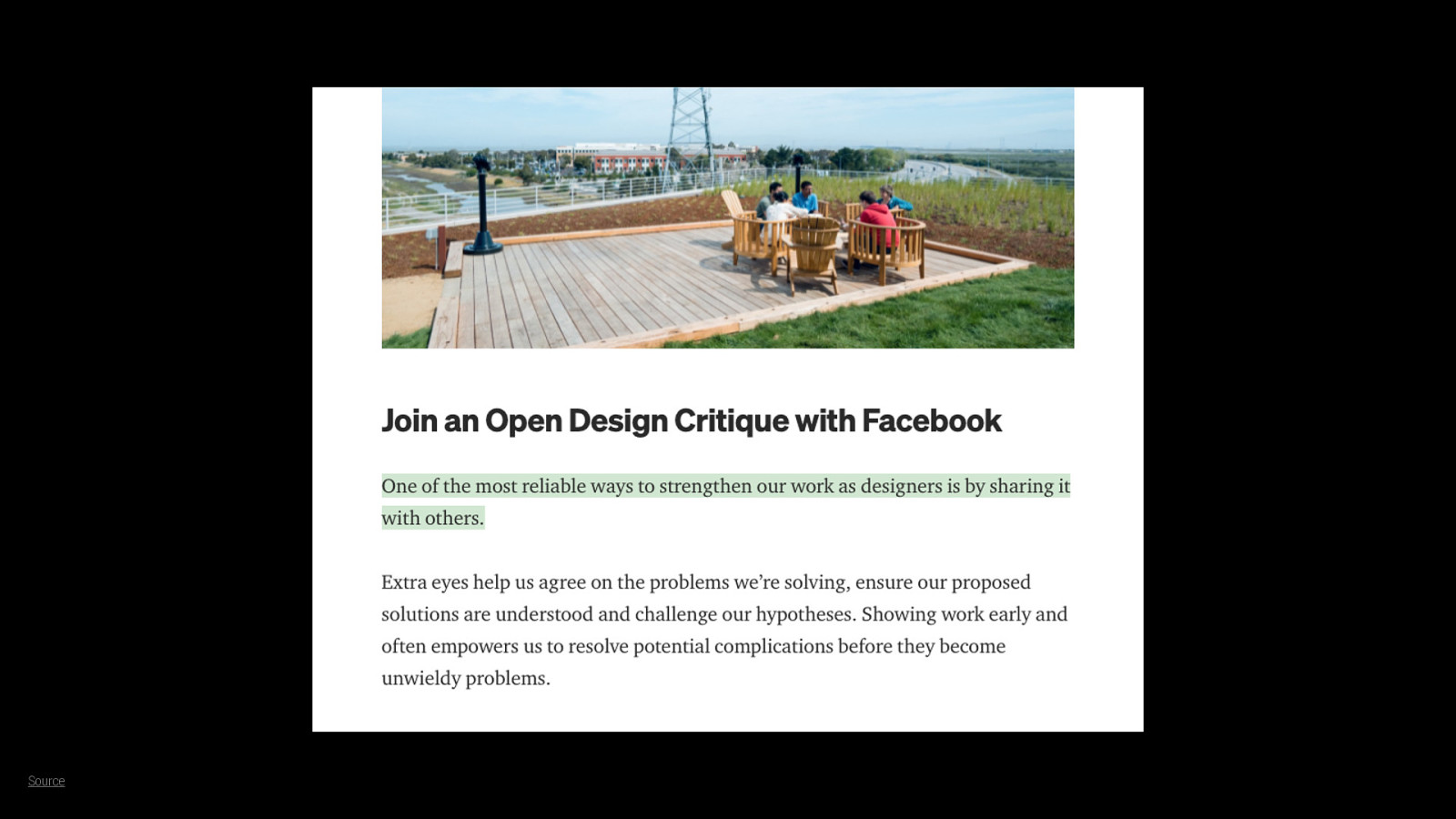
But there’s more to transparent recruiting than just publishing content.
A few years ago, Facebook invited people to join them in an open design critique. This was an opportunity for people to learn from designers working at Facebook, but also an opportunity for Facebook to find potential new designers to reach out to with job opportunities.
Tactics like this open up your practice and keep you top of mind for folks when they’re looking for new jobs.

One of the most important aspects of transparency in recruiting is being open about pay. When companies are transparent about compensation, it greatly reduces issues of unequal pay—especially for women, Black people, immigrants, and all marginalized and underpaid people.
There’s a global movement demanding compensation transparency in job posts. In the content design community, we see this in places like the Content & UX slack, thanks to the work of Jess Sand and the organizing team. There’s also legislation in some US states, Europe, and elsewhere that encourages or requires salary transparency.
But we shouldn’t just be transparent about pay and stop there. There’s a lot more we can open up about to increase equity and inclusion for our candidates.

Because people perform their best when they know what’s expected of them.
Think about the new hire experience after someone joins your team. You probably give them a full onboarding plan that walks them through everything they need to know to be successful: culture, values, expectations, the design system, the job ladder, what “good” looks like, 30/60/90-day goals, and so on.
You’d never make people on your team guess about these things. So don’t make your candidates guess, either.

Okay, so how can you build a transparent recruiting program at your company?
We’ve looked at lots of examples you could copy, but how will you know what’s best for you and the people you want to hire?

I’m going to walk you through how we did this at HubSpot last fall. Remember how I mentioned right at the beginning that I had to hire 9 content designers and that number quickly grew after I started? This is how we did it.
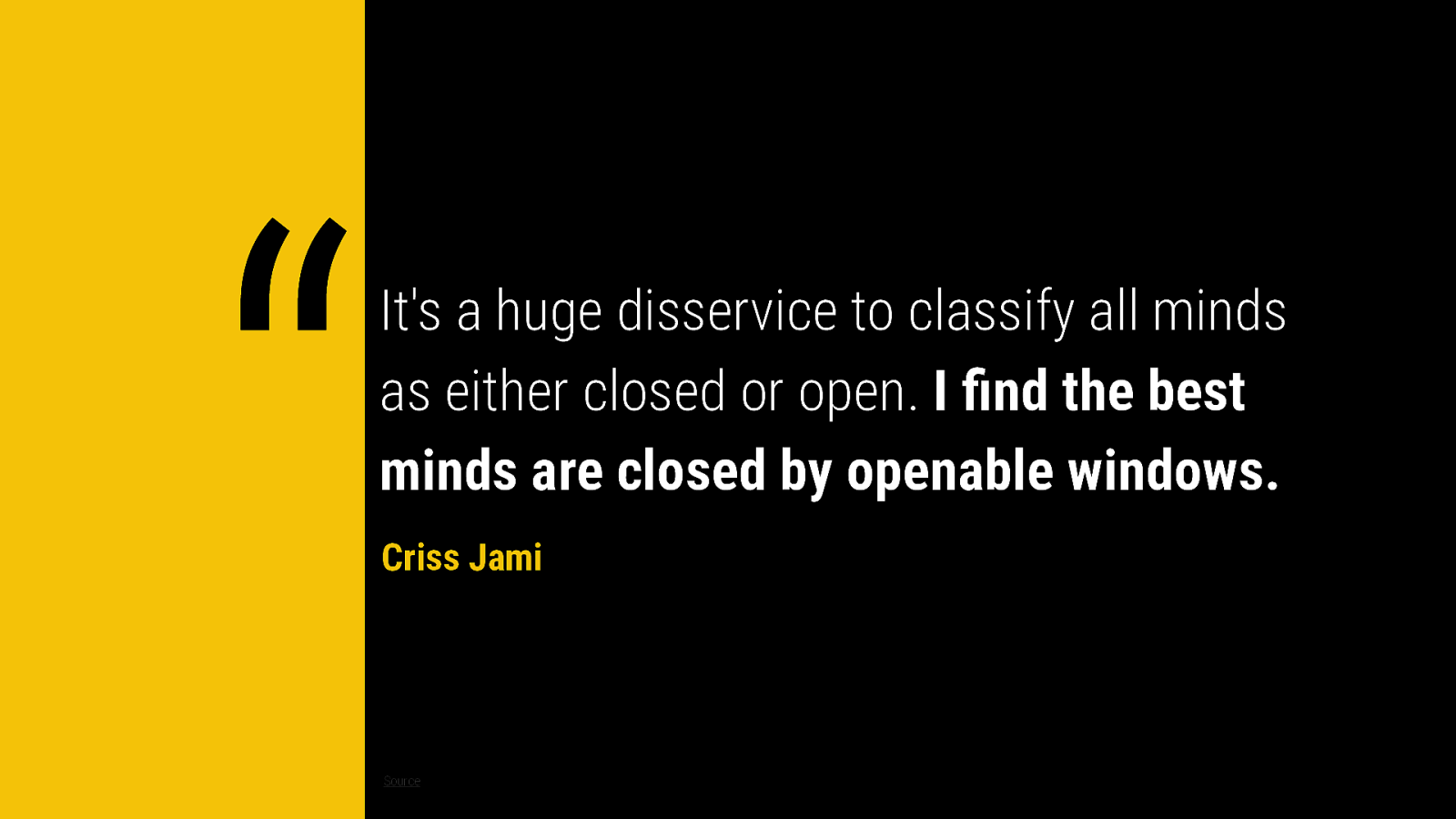
First, your team or company may not be set up for radical transparency, so you should try to understand why. What makes the way you do things so good that you’re not open to change?
Criss Jami gives us some insight into understanding how to influence people. As you dig into the details at your company, you’ll probably find all sorts of problems, data, and historical anecdotes that help paint a picture of why your system works the way it does… and why your partners think the way they do.
If you want to set up a new recruiting philosophy focused on transparency, then you’ll need to think big and ask a lot of hard questions to open the windows of their minds.

Here’s how we thought big at HubSpot. We started by asking ourselves, our team, and some of our newer hires and past candidates 4 key questions.
First, who are you looking for? You need to understand the people you want to hire in a meaningful way. What are their goals and ambitions? What compels them forward? What do they find inspiring or uplifting?

Then you need to understand what might be causing them pain. What are their frustrations and barriers to progress in their current role? How do they feel held back or limited? And what’s causing them anxiety or, in some cases, trauma?

I need to talk with you about organizational trauma because so many people talked with us about it during their interviews, and about how their workplaces and leaders had inflicted trauma upon them.
Humanity Centered’s report with DScout talks about how “The American workplace is a traumatized workplace.” And we know this is true all around the world, not just in the US.
Dysfunctional workplaces, hostile environments, the lack of psychological safety, processes intended to drive exclusion of marginalized people, the need to be always-on, the unending treadmill of work, weaponized performance reviews, shady or non-existent HR departments, and the structural racism, misogyny, and explicit cruelty of organizations, particularly during the pandemic, have all left their marks on workers.

Their bodies have kept the score.
So we can’t just skip past trauma when people share it with us. We owe it to them to acknowledge their truth and to show them the greatest possible care.
Out of everything we’ll discuss today, this is the most important reason why you should approach recruiting as a manager instead of as a marketer. You can stop the gaslighting and help people be seen, heard, and validated as you support them.

We can’t solve trauma with free t-shirts, resilience trainings, wellness apps, or fitness classes. But resources like Humanity Centered’s report along with the National Fund’s guide to building a trauma-informed workforce help us understand trauma, including how to identify it, recognize signs of its impact on people and groups, respond with empathy and humane practices, and to actively resist re-traumatizing people.
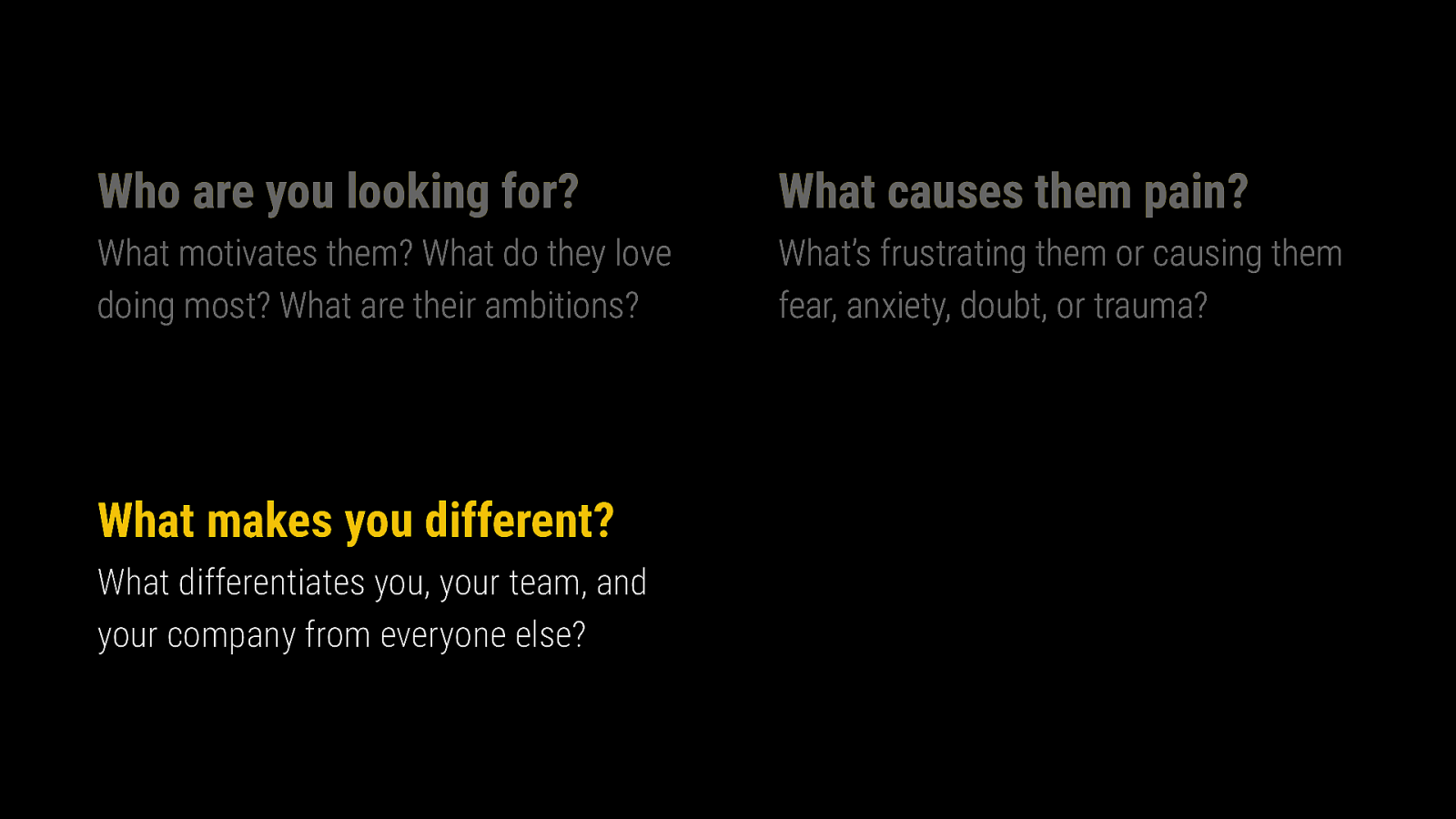
How our organizations learn from people’s trauma and respond to it is an important differentiating factor. It’s likely one of many things that makes you, your team, and your company different.
To get back to our 4 questions, you should take time to interrogate your differentiators and what you have to offer that no one else can. Beyond vague generalities like “world-class design,” “customer-centric,” or “build at scale,” what are your specific value props? What about your culture supports people? How do you set them up for success and wellbeing?

And finally, taking into account what you’ve learned from these three earlier questions, you should consider what makes your hiring process hard, challenging, and stressful for your candidates. How might you take away all of this friction and just make it easy?

To show you why this is important, I want to highlight a few things we do not do at HubSpot.
Here, a company asks some hard questions as part of their application process. It’s hard for an applicant to tell what a good answer looks like with the context given. How should they approach this? How can they figure out the criteria for “good”?
They can’t! And that’s just at the application stage, so they have to assume this approach is indicative of how the company will work with them throughout the process, as well as after they’re hired.
This ambiguity doesn’t set people up for success. If they were working on your team, you wouldn’t use unknowable criteria to judge their performance. So why do this with candidates?

And then we come to design exercises. Whether it’s a live whiteboard exercise or a take-home assignment, these are rife with biases, have unclear success criteria, and put unnecessary pressure on candidates just to see how they handle it.
Let’s dig into the bias piece: Live design challenges are biased against introverts, highly sensitive people, people who come from cultures where it’s impolite to interrupt or to be interrupted, neurodivergent people, and so, so many other folks.
So you might think that take-home assignments solve these problems, but they add entirely new ones. They’re biased against people who don’t have time for extra work—like parents, caretakers, people with multiple jobs, and, well, pretty much everyone. And while candidates are often told not to take more than a few hours on them, most people spend much more time than that. This is unpaid labor.

Jamal Nichols, a staff designer at Careem, is 100% correct: many companies use these exercises as a sort of catch-all to evaluate candidates’ skills. But if you can’t determine that from your conversations with them and reviewing their past work, then I’d argue that you don’t really know what you’re looking for.

And that just scratches the surface. There are moral, ethical, and practical reasons why take-home assignments and live design exercises like the ones you see here are bad for both candidates and companies.
Meaghan Li wisely points out how they often deter, delay, and otherwise disrupt the people who are likely to be your strongest candidates.
So if your process includes either a take-home assignment or a live challenge, then I’d urge you to stop leaning toward a biased process that often puts pressure on candidates just to see how they deal with it.
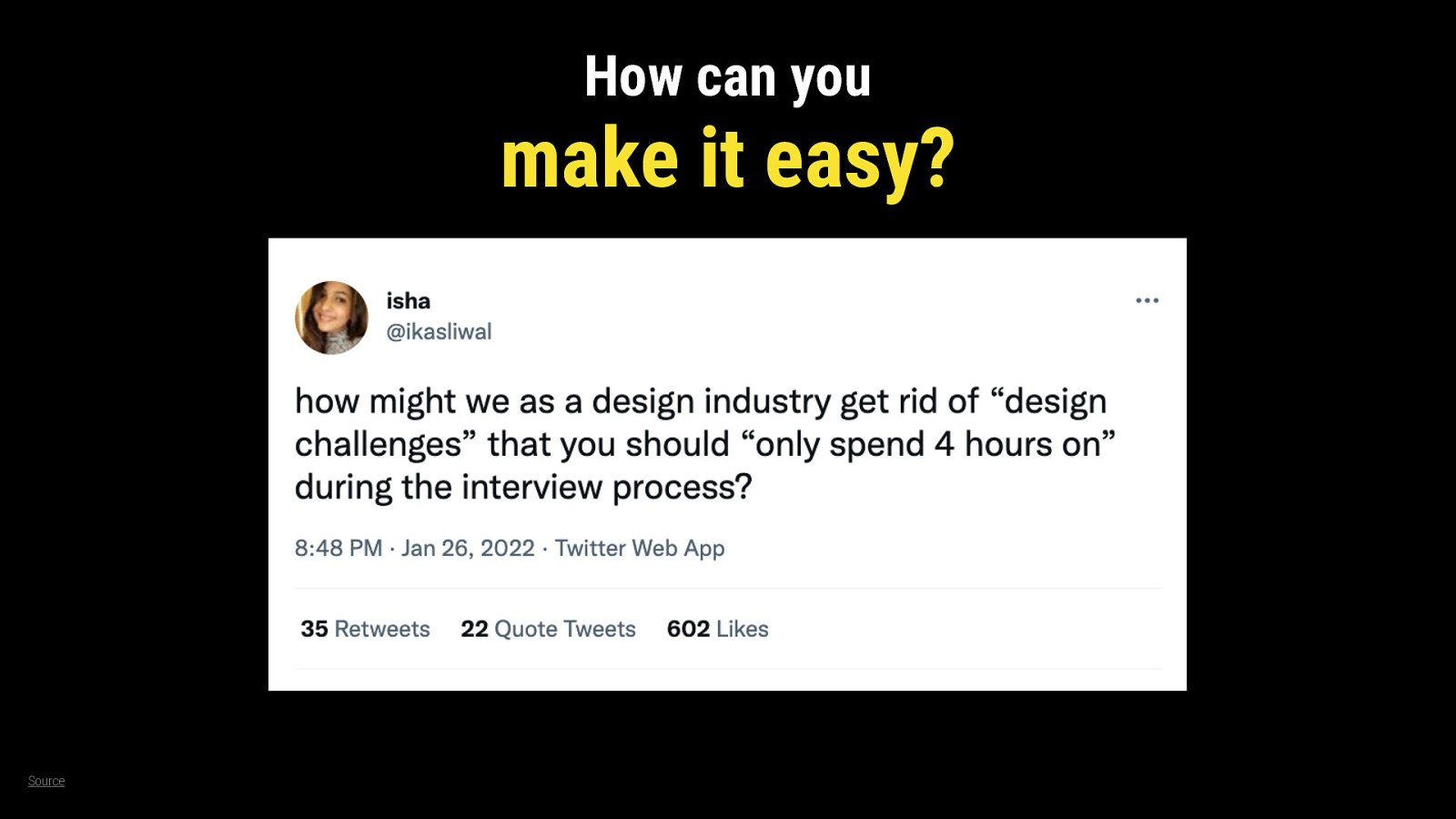
If you can’t get a sense of someone’s design skills, process, collaboration, values, and leadership after talking with them for several hours, then you should improve the quality of the conversations you’re already having with them.

Okay, rant over! So asking the four questions I showed you earlier led us to create two strategic pillars.
The first was to show people that we understand them. We did this by always centering the candidate in our messages, always focusing on “you” instead of on “we” or “us.” And we tried to address their pain points and frustrations, showing how they’d be set up for more growth and success with us.

The second pillar was to default to being open. Instead of hiding our expectations or what “good” looks like, we led with transparency and clarity instead. By defaulting to open, we took away the guessing game so that we could help more candidates succeed. This made things a lot easier for them!
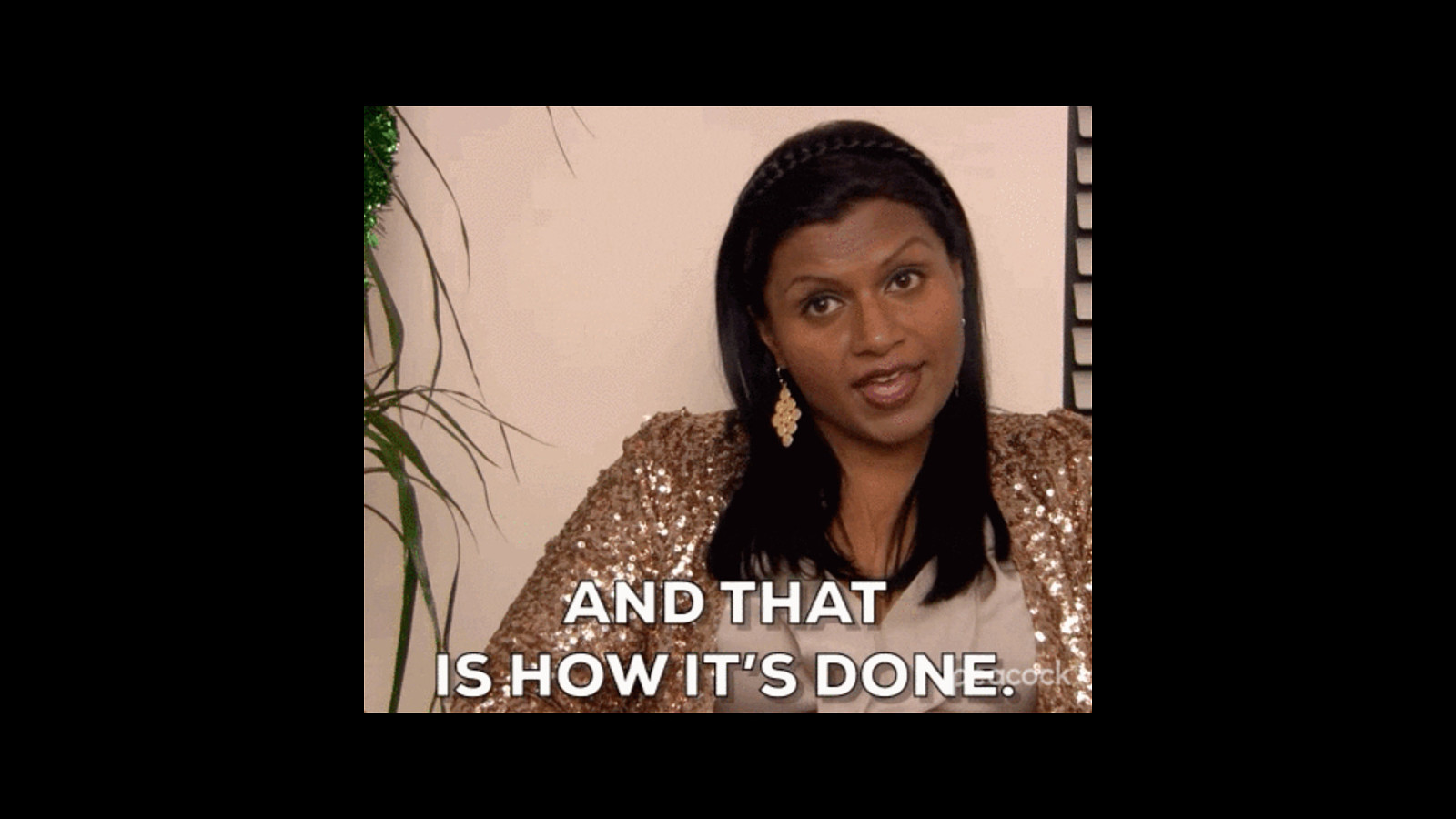
Four questions and two key strategic pillars. I could make it sound more complicated than that, but it’s not.

Now I’ll walk you through some of the outputs of this strategy so you can see how we applied this thinking.

Here’s a few key things we did in our job posts for our open content design roles. First, we say upfront what content design means to us. We point out directly that this role is focused on UX and product, not on content marketing or related competencies. Many candidates told us that this gave them confidence that they were applying for the right role.
Then we highlight that they might use different titles than us and reassure them that’s okay. This is important because, as Kristina Halvorson recently pointed out, content design titles are a hot mess express. So we shouldn’t turn someone away just because they call themselves, say, a UX writer or an information architect.

And rather than including a vague, bland statement about how diversity is important to us, we take a moment to engage in some Real Talk™️. I had a lot of help from the community creating this statement and have listed contributors at the bottom of the slide.
Here we show that we know people struggle with impostor syndrome and lack confidence, especially if they don’t “check all the boxes,” come from backgrounds that aren’t thought of as being “standard,” or have been marginalized or actively excluded in the past because they don’t look like me. {Point to your big, dumb face}
But beyond showing people that we understand them, we try to go the extra mile by sharing that we feel these things, too. And it’s no act—it’s how I feel most of the time. It’s how I feel right now. So I want folks who feel that way to know that I see them and welcome them, too.

Which leads us to another example of how we set up candidates for success instead of failure.
As part of our application process, we ask candidates to show us samples of their work. And we know from talking with them that this makes them nervous and vulnerable.
So we wrote this public blog post that shows exactly what we look for in these work samples, why those things matter to us, and how to pass the review with flying colors.
This creates far more equity for candidates because it levels the playing field, helping everyone start from the same point. It reduces bias toward people who already think and communicate like we do, increasing the opportunity for those who don’t to share their knowledge and expertise.

The goal here was to remove barriers to people applying by making it as easy as possible to create a clear portfolio. You might think this is a sort of “cheat sheet,” but it’s not. It just provides information equity so that they don’t have to read our minds.
Listen: putting together work samples is still really, really hard! But what we do here is take away the guessing game. We help candidates understand our expectations so they know what “good” looks like. People can do better work faster and more easily when there’s less ambiguity about how to be successful.

A key way we did that was to link off to several portfolios that we thought were good. Beyond setting expectations for our candidates, this also helped us highlight a number of great folks working in the field.
In particular, I tried to find people who were doing high-quality work, who came from diverse backgrounds, who worked around the world, and who were not already well-known in the content design field. These folks were thrilled to be featured and all gave us permission to highlight their amazing work.

We also show candidates the specific questions we ask whenever we look at design work.
This was intended to help them think through the kind of stories they should tell about their designs, how they made decisions, why their choices were good, and so on.

When candidates are in our interview process, we set them up for success by actively coaching them and sharing prep guides like the one you see here.
And as you can see, we really do ask those questions! With our coaching and by reviewing this prep guide prior to their interview, candidates can prepare more easily with far less stress. We help them do their best.

But this transparency doesn’t just stop with me or with the things we publish.
James Deer, founder of working in content dot com, also gave us the opportunity to do a live “Ask Us Anything” event with his community. This was an excellent opportunity for people to ask questions that they cared about of actual content designers working on our team.
I’m so grateful to Dayne Topkin, Catherine Carr, and Natalie Rohrer from HubSpot for being so brave, open, and straightforward with their answers.
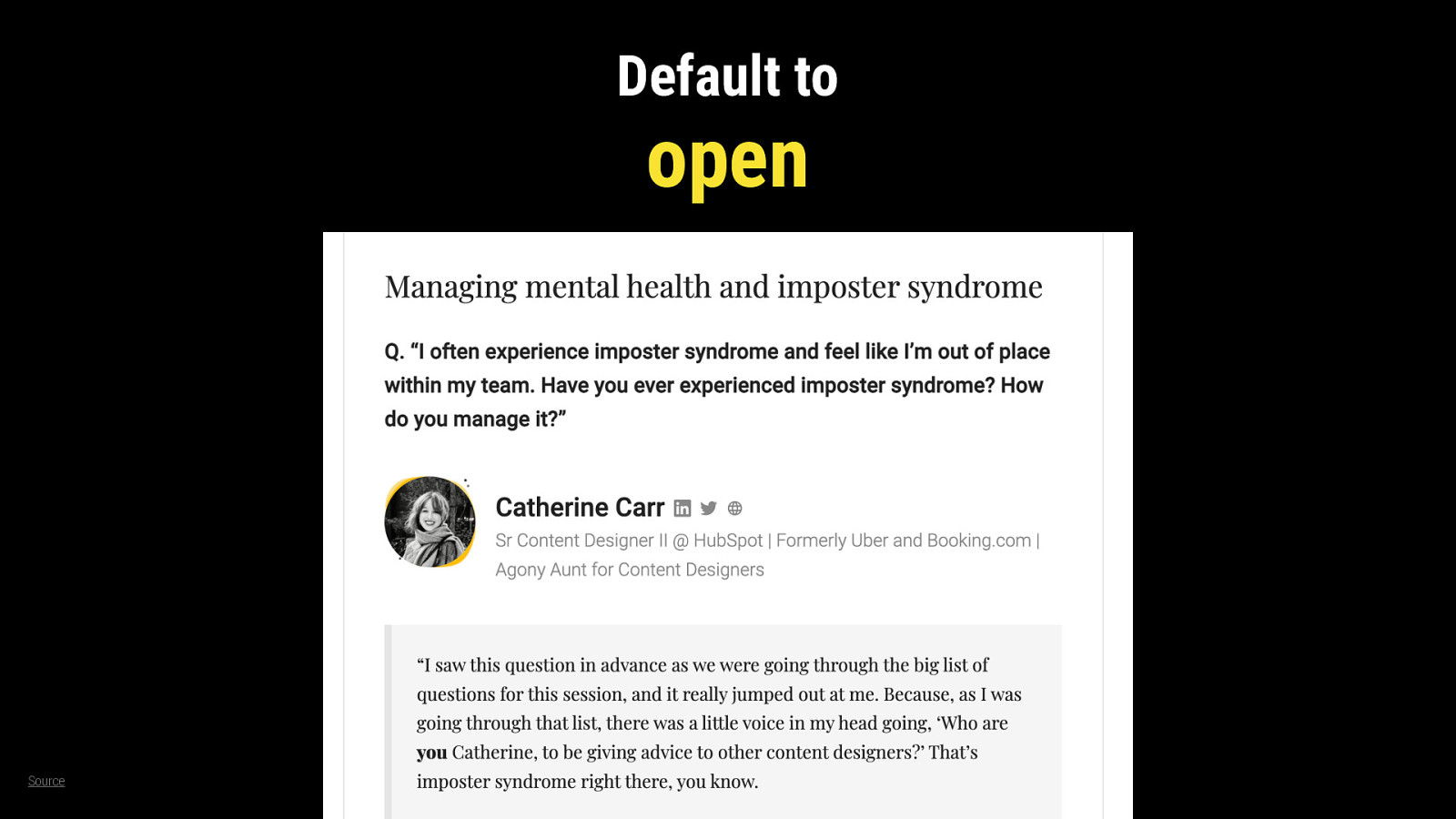
Here’s one of the many questions people asked, and it’s on a challenging subject: mental health and impostor syndrome. And rather than give a vague, general answer, Catherine Carr leads off by showing how this is something that she struggles with herself.
She’s just so real. And it shows people that we get them. And by being open about our own struggles, we validate other people, help them feel seen, and earn their trust.

This really is a better way to engage in recruiting. Not as an adversary, but as a coach. Not as a marketer, but as a manager.
By showing people that you understand them. And then defaulting to open.
Because people perform their best when they know what’s expected of them.
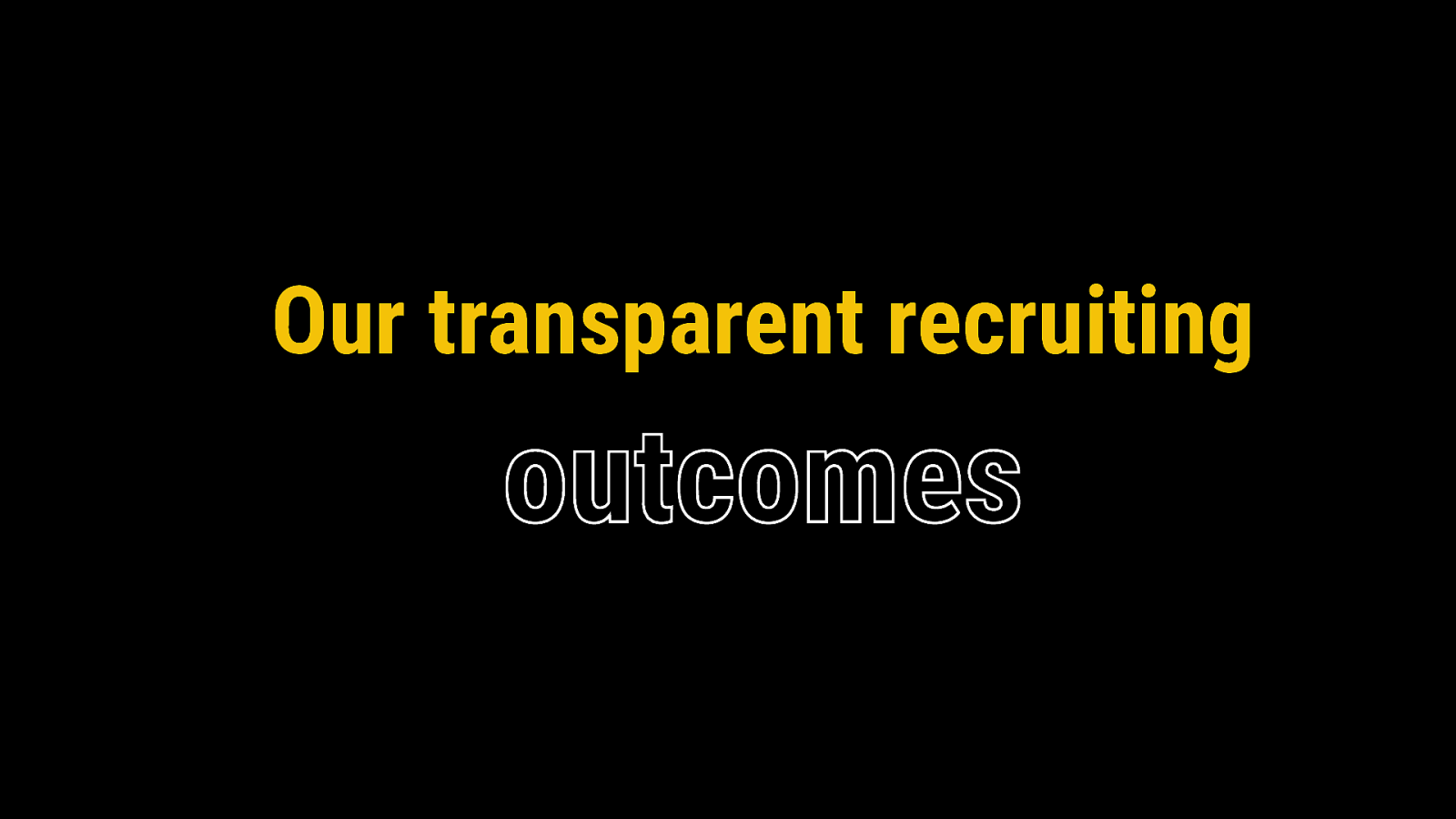
So maybe that all looks good in a slide deck, but did it actually work? You be the judge.

We earned well over a thousand organic applications for our content design roles in just five months. None of these were sourced through direct outreach, bought from lists, or contacted by spam. And I didn’t have an army of recruiters or a massive ads budget—these organic applications were driven by me and my one recruiting partner.
We did this during a period when candidates had more opportunities open to them than ever before. And we had more competition from other companies who also wanted to hire these same people.
But they still chose to apply to us. Why? Because we showed them upfront, before they talked with us, that we understood them, and we made it easy, and we defaulted to being open.

We conducted over 200 interviews with incredibly talented people and I wish I could have hired all of them. But because we’d earned their trust and built strong relationships with them from the start, they felt empowered to give us feedback along the way and help us improve our process.
So as we coached them and set them up for success, they reciprocated and helped us get better, too. Our transparency and their generosity is what made this ongoing improvement possible.

Ultimately, we hired 16 content designers in just 5 months. This more than doubled the size of HubSpot’s content design team.
These people are now creating value across our entire product org and solving our customers’ problems. And it’s all because we invested the time to design their hiring experience and approach them like managers instead of like marketers.

We also developed hundreds of new, long-term relationships with people all over the world doing work that we admire. We’ll come back to them in the future as they develop and we continue to open new roles.
These relationships will continue to speed up and scale our hiring as we grow. Our teams tend to grow by over 40% year over year. So knowing these great people will help speed up our hiring efforts as we grow.

Listen: we’re not exceptional in any way! You can do this, too. This strategy is simple, repeatable, and just like it set our candidates up for success, it can do the same for yours.
And when you try transparent recruiting, you’ll find what I found: it just feels right. It feels good when you remove artificial barriers from people’s paths, when you give them clarity instead of making them guess, and when you set them up to succeed instead of to fail.

Let’s recap: first, stop taking an adversarial approach to candidates. I know you’ve been a candidate yourself, many times, so you know first-hand what a bad experience this can be. It doesn’t set you up to do your best.

Don’t scale at any cost—instead, invest in candidates as if they’re already on your team. Support and guide them, coach them with feedback, and approach them as a manager instead of as a marketer.

Then ask the hard questions to understand the people you want to bring onto your team. Deeply empathize with their goals, their struggles, and the pain or trauma they might feel.
Everyone wants to be seen and recognized. And we do this all the time with people on our teams, but so rarely with our candidates.

And then make it easy. Remove artificial barriers like meaningless qualifications that exclude people, biased tests and homework assignments, and highly pressurized scenarios just to see how people deal with them.
This greatly reduces the impact of your biases. It helps more people who don’t already think and work like you to enter your process. And it gives them confidence that you’re not excluding them for things that are beyond their control.

Finally, default to open. Don’t make them guess or force them to read your mind.
Just be open. It saves your candidates—and you—time, energy, anxiety, and doubt while building your confidence… and your team.

These practices make up our approach to transparent recruiting. These five simple ideas will transform the way you work with people to set them up for success even before they join your team.
And over the long-term, they’ll have greater impact, add more to your culture, stay with you longer, and grow higher, further, faster, and more in their careers.

Why? Because people will always perform their best when they know what’s expected of them.

And that’s how you do transparent recruiting: a new approach to being radically open with candidates to support their success.

I’m Jonathon Colman from HubSpot.

And I can’t wait to hear about how you apply these ideas to your own recruiting practices. So please share them with me so that we can all continue learning and growing together. I’m at jcolman on Twitter and LinkedIn.

And again, you can get these slides and all related resources at transparent recruiting dot com.

Thank you all so, so much.